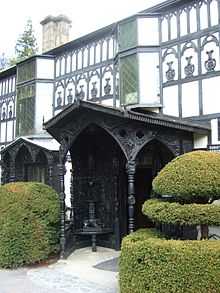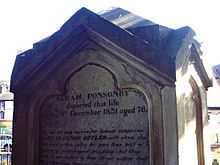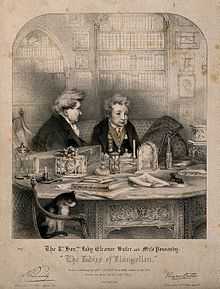Ladies of Llangollen


The Ladies of Llangollen were two upper-class women from Ireland whose relationship scandalised and fascinated their contemporaries.[1]
Early lives
Eleanor Charlotte Butler (11 May 1739 – 2 June 1829 (age 90)) was a member of one of the dynastic families of Ireland, the Butlers, the Earls (and later Dukes) of Ormond. Eleanor was considered an over-educated bookworm by her family, who resided at the Butler family seat Kilkenny Castle. She spoke French and was educated in a convent in France. Her mother tried to make her join a convent because she was remaining a spinster.
Sarah Ponsonby (1755–9 December 1831 (age 72-76)) lived with relatives in Woodstock, County Kilkenny, Ireland. She was a second cousin of Frederick Ponsonby, 3rd Earl of Bessborough, and thus a second cousin once-removed, of his daughter the Lady Caroline Lamb.[2]
Their families lived only two miles (3 km) from each other. They met in 1768, and quickly became friends. Over the years they formulated a plan for a private rural retreat.

Flight
Rather than face the possibility of being forced into unwanted marriages, they left County Kilkenny together in April 1778. Their families hunted them down and forcefully tried to make them give up their plans – in vain.
They decided to move to England, but ended up in Wales and set up home at Plas Newydd near the town of Llangollen[4] in 1780. They proceeded to live according to their self-devised system, though they could rely on only a modest income from intolerant relatives. They restructured Plas Newydd in the Gothic style with draperies, arches and glass windows.[5] They hired a gardener, a footman and two maids. This led to significant debt, and they had to rely on the generosity of friends.
They devoted their time to seclusion, private studies of literature and languages and improving their estate. They did not actively socialise and were uninterested in fashion. Over the years they added a circular stone dairy and created a sumptuous garden. Eleanor kept a diary of their activities. Llangollen people simply referred to them as "the ladies".
After a couple of years, their life attracted the interest of the outside world. Their house became a haven for visitors, mostly writers such as Robert Southey, William Wordsworth, Percy Shelley, Lord Byron and Sir Walter Scott, but also the military leader the Duke of Wellington and the industrialist Josiah Wedgwood; aristocratic novelist Caroline Lamb, who was born a Ponsonby, came to visit too. Even travellers from continental Europe had heard of the couple and came to visit them, for instance Prince Hermann von Pückler-Muskau, the German nobleman and landscape designer, who wrote admiringly about them.
The ladies were known throughout Britain, but have been said to have led "a rather unexciting life".[6] Queen Charlotte wanted to see their cottage and persuaded the King to grant them a pension. Eventually their families came to tolerate them.
Butler and Ponsonby lived together for the rest of their lives, over 50 years. Their books and glassware had both sets of initials and their letters were jointly signed.
Eleanor Butler died in 1829. Sarah Ponsonby died two years later. They are both buried at St Collen's church in Llangollen.[6]
Heritage
The ladies' house is now a museum run by Denbighshire County Council. Butler's Hill, near Plas Newydd, is named in honour of Eleanor Butler. The Ponsonby Arms public house, a Grade II listed building on Mill Street in Llangollen,[7] claims to take its name from Sarah Ponsonby.[8]
In April 2011, the same month in which the first Irish civil partnerships took place under the Civil Partnership and Certain Rights and Obligations of Cohabitants Act 2010, Irish state broadcaster RTÉ broadcast a 45-minute radio documentary about the lives of Eleanor Butler and Sarah Ponsonby entitled "An Extraordinary Affair". It asked whether they were Ireland's first openly lesbian couple, but offered no evidence that their relationship was sexual.[6]
See also
References
- ↑ Fullest treatment in The Ladies of Llangollen by Elizabeth Mavor, Penguin 1971
- ↑ Shows extracts from other sources, see in particular, Gentleman's Magazine, 1829 [3]
- ↑ "Miss Sarah Ponsonby". The Ladies of Llangollen.
- ↑ Google map
- ↑ Plas Newydd at llangollen.com
- ↑ 6.0 6.1 6.2 O'Donnell, Leeanne An Extraordinary Affair at RTE Radio
- ↑ Ponsonby Arms at britishlistedbuildings.co.uk/
- ↑ The Ponsonby Arms
External links
| Wikimedia Commons has media related to Ladies of Llangollen. |